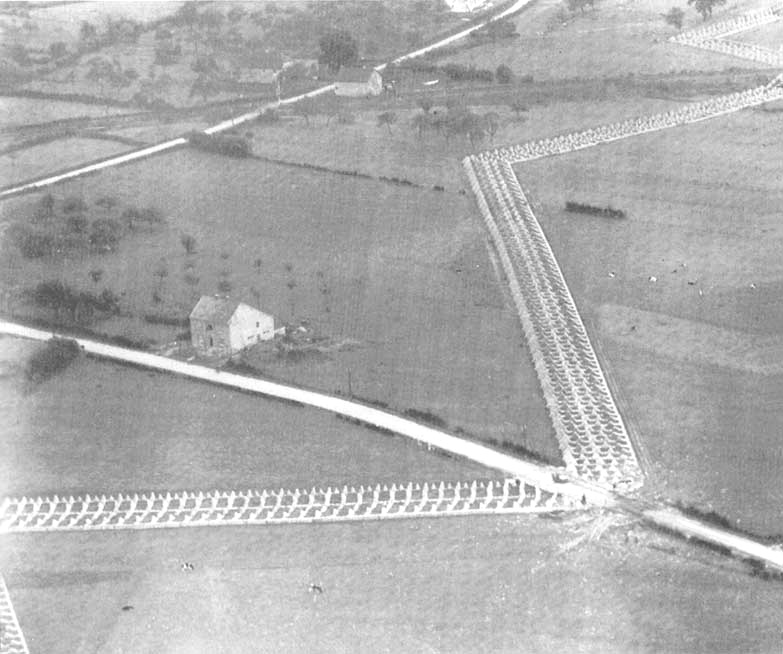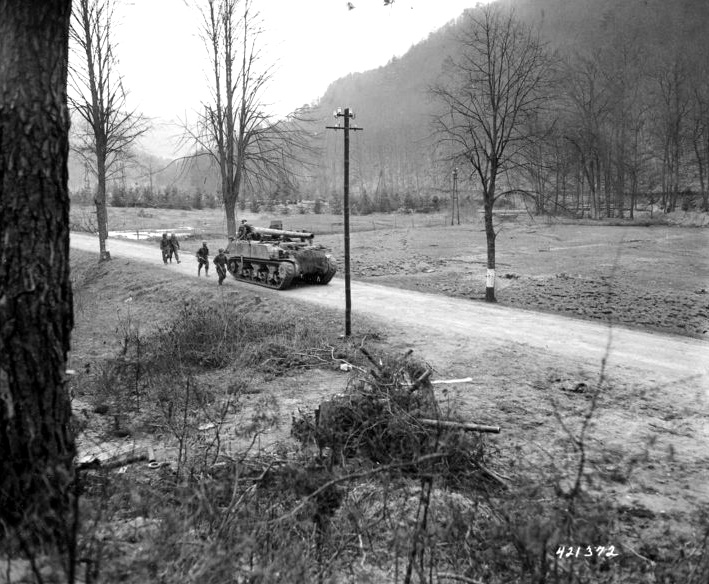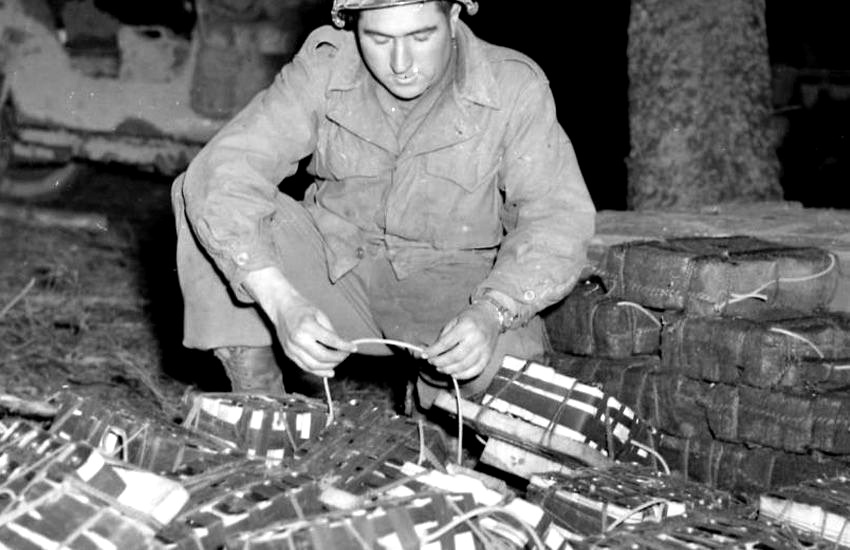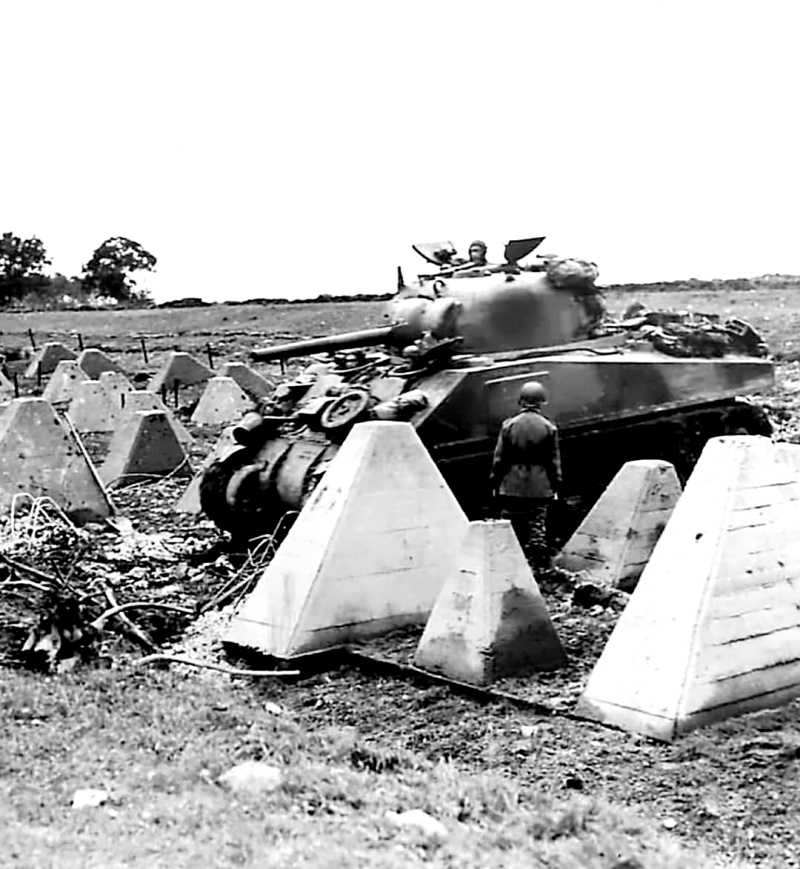Document Source: Appendix C, Narrative Account of the 117th Infantry Regiment, Interview with Col Robert E. Frankland, CO 1/117th Infantry; Maj Henry R. Kaczowka, Battalion Executive; Capt David K. Easlick, Battalion S-3; Lt Stanley W. Cooper, Dog Co, Heavy Weapons; Lt William J. O’Neil, Leader Pioneer Platoon. October 12, 1944. Interview conducted by Capt Hechler, Assistant Corps Historian.

The following archive is related to the operations of the 117th Infantry Regiment, 30th Infantry Division, during the Breaching of the Siegfried Line and particularly in the crossing of the Wurm River east of Scherpenseel in Germany on October 2, 1944.
PILLBOXES REDUCTION
(a) – General
The German pillboxes were admirably sited to take full advantage of the defensive potential of the terrain. Their reduction, however, and the surrender of their occupants were realized through a variety of very simple but militarily sound methods. The elaborate, concrete strongpoint reduction technique as used on the Atlantic Wall and as taught at the Engineer and Infantry schools in the United States was neither used nor applicable. In reducing the pillboxes, small-arms fire through the embrasures played an important part. German instructions for using the pillboxes called for most of the personnel to remain outside in firing positions around the pillboxes. Only 30 or 40 percent of the pillbox complement would be permitted to remain inside the box; the box normally fired in only one direction and was dependent upon protection by adjacent boxes; neutralizing these adjacent boxes with direct artillery, tanks, and small arms fire permitted assaulting infantry to work around to the rear, unprotected entrance to the pillbox. If the pillbox personnel did not surrender by this time, a bazooka or tank shell through the rear door would normally clinch the argument. Once the 30th Infantry Division was through the pillboxes line at Palenberg – Ubach it turned south. This rolled the pillbox line up from its north flank and rear. Virtually, as many methods were used as units engaged. All were simple and involved the same basic principle of a straight infantry assault on any small defended knoll. The most effective was probably the infantry platoon supported by 3, ar 4 tanks working closely together with no special equipment other that a Rocket Launcher 2.36′ (60-MM), aka Bazooka.
Capt Richard J. Wood, S-3, 2/117-IR (30-ID)
The careful training had little relation to the actual way in which the pillboxes were reduced.
Maj Ben T. Ammons, CO, 2/117-IR (30-ID)
Capt Richard J. Wood, S-3, 2/117-IR (30-ID)
Some pillboxes of course were tougher than others. But generally, they were not as hard to reduce as was foreseen. They were in clusters, all inter-supporting and sited to cover each other by fire. But due to the limited traverse of their fields of fire, there seemed to always be one at least in a group, which, if reduced, permitted our men to start a circuit of the remaining pillboxes, using approaches to each succeeding one that could not be covered by the fire of the remaining ones. The problem, of course, was to discover the key pillbox to each cluster.
(b) Methods and Effectiveness
ARTILLERY: The effect of direct artillery hits on the pillboxes, except the 155-MM SP gun and possibly heavier calibers, was not sufficient to destroy the box or prevent its future use. The concussion by a direct hit certainly discouraged not-too-strong-hearted defenders. The 57-MM AT gun, 75-MM, 76.2-MM, and 105-MM were ineffective except for a direct hit in the embrasures. They could remove the camouflage but little else. The 155-MM howitzer required an uneconomical number of rounds to secure direct hits. The 155-MM SP guns at ranges between 2000 and 4000 yards with a concrete bursting fuze penetrated the 6 feet of reinforced concrete with 3 to 5 hits. The 8-inch (203.2-MM) howitzers at 8000 yards could average a direct hit per 5 rounds, and penetrate after 5 hits. The major contribution of the artillery fire was to drive external defenders inside and to force defenders inside to come out and surrender after direct hits were secured.
2/Lt E. Robinson, FO with Baker Co 117-IR
For nearly a week prior to our unit’s crossing, we manned static OPs and did multiple firing on pillboxes; the effect was almost negligible … At one time a self-propelled 155-MM gun was pulled up at the OP I was on, and fired directly at a range of approximately 1500 yards. In 12 rounds fired he scored 7 hits. The only effect on the pillbox was about 4 feet of concrete removed am some dirt off the top. The enemy inside was probably shaken up by the impact but otherwise unhurt.
Capt Harley M. Force, Jr., 197-FAB
We have found that Tank Destroyer and 105-MM projectiles bounce off of the pillboxes. They will rupture or penetrate when they hit the embrasures. The 155-MM howitzer, using a Concrete Bursting Fuze, will rupture and penetrate when an actual hit is made but on account of dispersion, this requires about 25 to 30 rounds. Using the 155-MM SP (GPF) (Grande Puissance Filloux – High Powe Filloux) at ranges between 2000 and 4000 yards, a penetration is secured. Under 2000 yards the projectile disintegrates upon striking this concrete surface. Above 2000 yards, using the 155-MM (SP) GPF HE shell mounted with a Concrete Bursting Fuze, with 3 to 5 rounds we have penetrated six feet of reinforced concrete. The 155-MM (M-1) like the 155-MM Howitzer has too much dispersion and can it be brought sufficiently close up. The 8-inch Howitzer (203.2-MM) is the best weapon we have to bust the pillboxes when used at about 8000 yards. Below this range, it has too much dispersion. A direct hit will disintegrate a pillbox. It has taken an average of about 5 rounds to obtain a hit. In all cases, the dirt has to be knocked off the pill box before it can be successfully engaged. We use 105-MM and 155-MM Howitzers with HE delayed fuze for this purpose.
Col Otto Ellis, Executive Officer 30-ID Artillery
As an example of the ineffectiveness of artillery fire on the pillboxes, an M-7 (HMC) (Howitzer Carriage Motor) was brought up within 1000 yards of a pillbox and 24 hits were scored, none of which penetrated. Some smoke was seen emanating from the rear of the pillbox after one shot. The M-7 then pulled out and an M-12 (155-SP) was brought up and seven hits were scored. One of these seven resulted in smoke coming out of the rear of the pillbox. One and a half hours later, the 197th Field Artillery Battalion was called upon to fire on the same pillbox because the Germans had come out and were standing in the open.
Col D. V. Bennett, CO 62-AFAB
Shooting at a 700-yard range on October 2, hits from an M-12 knocked concrete off the pillbox, but did no other visible damage.
Lt Arthur G. Keller, 2d platoon leader B Battery, 258-FAB (155-MM SP M-12)
43 pillboxes were attacked by short-range M-12 fire, 1 by direct fire. M-12 adjusted using fuze delay, switching to T-105 fuze on obtaining the first target shot. Evidence of penetration was obtained on all targets.
Col Bradford Butler, 258-FAB (155-MM SP M-12)
Artillery fire succeeded in the first step of the reduction of the pillbox, namely, to force the personnel from the supporting gun positions into the pillbox. This fire kept the personnel there while the tanks moved up to deliver close-range fire, 30 to 50 yards in some cases. This blinded the pillbox so the infantry could close in on the blind side.
Hq 2/67-AIR, 2-AD
Due to heavy artillery fire, the infantry could not move with the tanks. Consequently, we had to have a thorough artillery concentration preparation both before and during the time that the tanks moved in on the pillboxes. The preparation was on the dug-in positions so as to pin the enemy down, enabling the tanks to move without danger of Panzerfaust or Panzerschreck fire. We found that time fire was the most effective.
AIR: Very little of the saturation bombing landed in the target area. Thus, no pillbox is known to have been affected by the air strike. Prisoners of War taken later stated that some of them had been asleep in pillboxes during the air strike and did not know the air strike had taken place. However, incendiary bombs dropped on pillboxes on the north flank were very effective on the personnel dug in supporting the concrete installations. In the weeds to the south, the effect of the incendiary bomb was negligible due to the dampness of the ground and the fact that the foliage and underbrush were still green. From October 2 to October 25, 41 missions of close support were flown in the division zone. Five enemy counterattacks were hit by air support, some of which were within 200 yards of front-line troops. On October 11, 14 squadrons were used to help break up a reported 50 tanks and considerable infantry in the Wurselen area.
Col W. M. Johnson, CO 117-IR (30-ID)
The saturation bombing on October 2 prior to the attack did no good. However, two groups of medium bombers who came in late, seeing the red smoke marking in Palenberg for the dive bombers, came in and bombed. This, with the operations of the dive bombers, produced good results in Palenberg. According to PW’s statements, the personnel under cover were unhurt.
Col H. E. Hassenfelt, G-3, 30-ID
Having contacted many of our own personnel as to their firings and from information obtained from PWs, it is the consensus that the air strike, preceding our attack on the morning of October 2, was absolutely ineffective. PW stated that some who were asleep in the pillboxes did not even know the air had bombed.
Col Robert E. Frankland, CO, 1/117-IR
The air strike did not hit any of the pillboxes in the 117th sector. Palenberg was bombed quite effectively, but the net advantage of the strike was very little.
DEMOLITION CHARGES: In general, these were not used as the pillbox personnel surrendered before demolition was necessary. However, 26 three-and-four man demolition teams were attached to the infantry assault troops. These men carried Bangalore torpedoes and satchel charges and aided the infantry with demolition work and checking for mines.
Report 30th Infantry Division
Pole charges which can be carried by assault platoons cannot destroy a pillbox but may blow in the rear door or the armored shield at the gun embrasure.
Report 30th Infantry Division
In the assault of pillboxes the engineers were employed with Bangalore torpedoes and pole charges with the assault p1Jltoon. The use of such charges was not found necessary if the tanks could fire into the rear doer.
BAZOOKAS: These were found highly effective for direct fire at the pillbox embrasures and for penetrating rear doors.
Capt Richard J. Wood, 2/117-IR
We found that bazookas were highly effective at the 100-yard range. When we fired bazookas on one pillbox, the occupants ran out from the gun section to the living quarters and then were apparently too scared to return. It was the bazookas more than anything else that reduced the pillboxes.
DIRECT SMALL ARMS FIRE: This was used considerably and proved extremely effective. Many PWs stated that opening the firing embrasure immediately resulted in the man attempting to fire through it being killed by accurate small arms fire.
Col Robert E. Frankland, CO, 1/117-IR
An officer PW stated that every time an embrasure was opened to fire MG’s, the gunner got shot so they had to keep ports closed: that our use of pole charges and tactics of sneaking in behind the pillboxes to attack and our method of reducing pillboxes and delivery of small fire is excellent.
Lt Kline, IPW Team, 30th Infantry Division
Officer PW’s expressed amazement at the accuracy of our riflemen in the manner in which enemy soldiers and weapons were picked off thru the pillbox apertures by our riflemen.
BULL AND TANK DOZERS: In some instances, particularly when the pillboxes were on flat or gently sloping ground, the rear door of the pillbox was sealed by a jeep-towed arc welder; then both the rear entrance and firing aperture were completely covered with earth by either a bull or a tank dozer. German PWs taken have expressed their fear of being buried alive after seeing and hearing of this technique. Pillboxes were also destroyed by demolitions after capture to deny their use to the enemy in the event of a successful counterattack.
Col Charles G. Rau, 7th Armored Group, (Report CO, 743-TB)
Tank dozers covered embrasures and entrances in the instances where these were low enough to the ground.
Col. J. E. Wynne, 67th Armored Regiment
We seal the pillboxes with the tank dozer only as a temporary measure. Our engineers follow us up and weld the doors shut. We found that dozing alone is ineffective, as is the method of blowing the handles off the doors. The tank dozer always drew unusually heavy enemy fire and was put out of action three times during the operation.
FLAME THROWER: In general, flame throwers were not used. Testing the flame-thrower however, within view of some pillboxes made the subsequent encirclement by the infantry immediately followed by the capitulation of the box.
Capt Wayne, Exec. Officer, 1/119-IR
We have had no occasion to use flame throwers against pillboxes as the Germans defend mostly from the trenches on the outside. Yesterday we had captured a pillbox and by operating the flame throwers through the embrasure and around the corners we cleared out the fire trenches.
Col Robert E. Frankland, CO, 1/117-IR
In the case of one pillbox in each of the two assault company sectors, flame throwers proved the most persuasive tool in forcing the crew inside to capitulate.
SATCHEL CHARGES: As obvious from the above discussion, these were unnecessary.
Maj B. Emmons, 2/117-IR
Satchel charges did not prove of value; in one instance we placed a 25-pound charge against the rear door of a pillbox and it hardly blew the door out of line.
TANKS: Tank fire to reduce a pillbox was a kind of wasted ammunition except for using it as cover fire for attacking infantry and engineers. The tanks were of great value in neutralizing adjacent pillboxes and closing with the pillboxes was a great inducement to surrender. As stated in the narrative of the attack, the first day’s operations were entirely infantry and engineer assault; thereafter tanks assisted materially in the reduction of most of the pillboxes.
























